| Srl | Item |
| 1 |
ID:
095575


|
|
|
| 2 |
ID:
103435
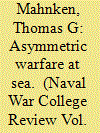

|
|
|
| 3 |
ID:
103797
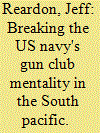

|
|
|
| 4 |
ID:
100674
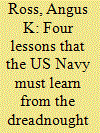

|
|
|
| 5 |
ID:
124230


|
|
|
|
|
| Publication |
2013.
|
| Summary/Abstract |
An increasingly important part of the new American Way of War has been a reliance on standoff technology to project power. The "lure" is minimal friendly casualties and short, inexpensive wars with only limited landpower commitments. Unfortunately, inflated expectations for such an outcome have often led to strategic overreach and a dangerously unbalanced force structure, ultimately costing the nation more blood and treasure. As the United States tries to refocus its strategy and reduce defense expenditures, it must be careful to retain a balanced force with a full range of capabilities.
|
|
|
|
|
|
|
|
|
|
|
|
|
|
|
|
| 6 |
ID:
100663
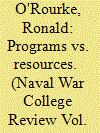

|
|
|
|
|
| Publication |
2010.
|
| Summary/Abstract |
The Navy, like other U.S. military services, faces a challenge in funding various program goals within a budget that is expected to experience little or no real growth. This challenge will be compounded if the change in the nation's projected budget and debt situation that has developed since the 2008 financial crisis leads to a real decline in the Department of Defense (DoD) budget.
|
|
|
|
|
|
|
|
|
|
|
|
|
|
|
|
| 7 |
ID:
100664
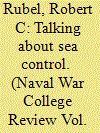

|
|
|
|
|
| Publication |
2010.
|
| Summary/Abstract |
The year 1990 was a significant one in naval history. It marked the transition from a world in which the oceans were contested to one in which one navy had uncontested command of the sea. The evidence for this shift is that during the run-up to the first Gulf War with Iraq, the U.S. Navy positioned half of its total aircraft carrier striking power in narrow seas, splitting it between the Red Sea and the Persian Gulf. If there was any conceivable threat, such a move would have constituted strategic Russian roulette. The incipient demise of the Soviet Union and the evaporation of its fleet, along with Iran's decision to stand aside, made the only threat to U.S. ships the stub oil platforms in the Persian Gulf and some mines in the gulf's northern reaches.
|
|
|
|
|
|
|
|
|
|
|
|
|
|
|
|
| 8 |
ID:
100739
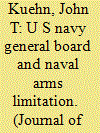

|
|
|
|
|
| Publication |
2010.
|
| Summary/Abstract |
The naval treaty system inaugurated at Washington in 1922 channeled innovation in the U.S. Navy. The Washington Naval Treaty eliminated the ability of the United States to construct new bases or to improve existing ones in the western Pacific. It fell to the General Board of the Navy to implement the clauses of the Washington Treaty. The General Board was also charged with the responsibility of preparing and attending subsequent naval conferences during the period. The General Board was the critical link between the Navy and the naval treaty system. As such, the General Board both shaped and was shaped by the treaty system.
|
|
|
|
|
|
|
|
|
|
|
|
|
|
|
|
| 9 |
ID:
093870
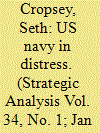

|
|
|
| 10 |
ID:
095576
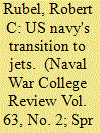

|
|
|
| 11 |
ID:
105561


|
|
|